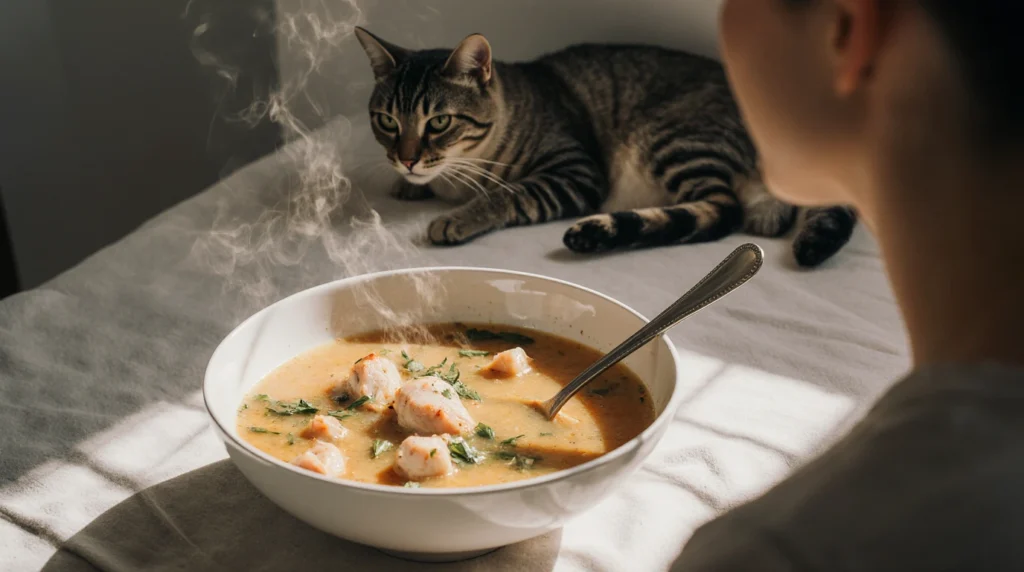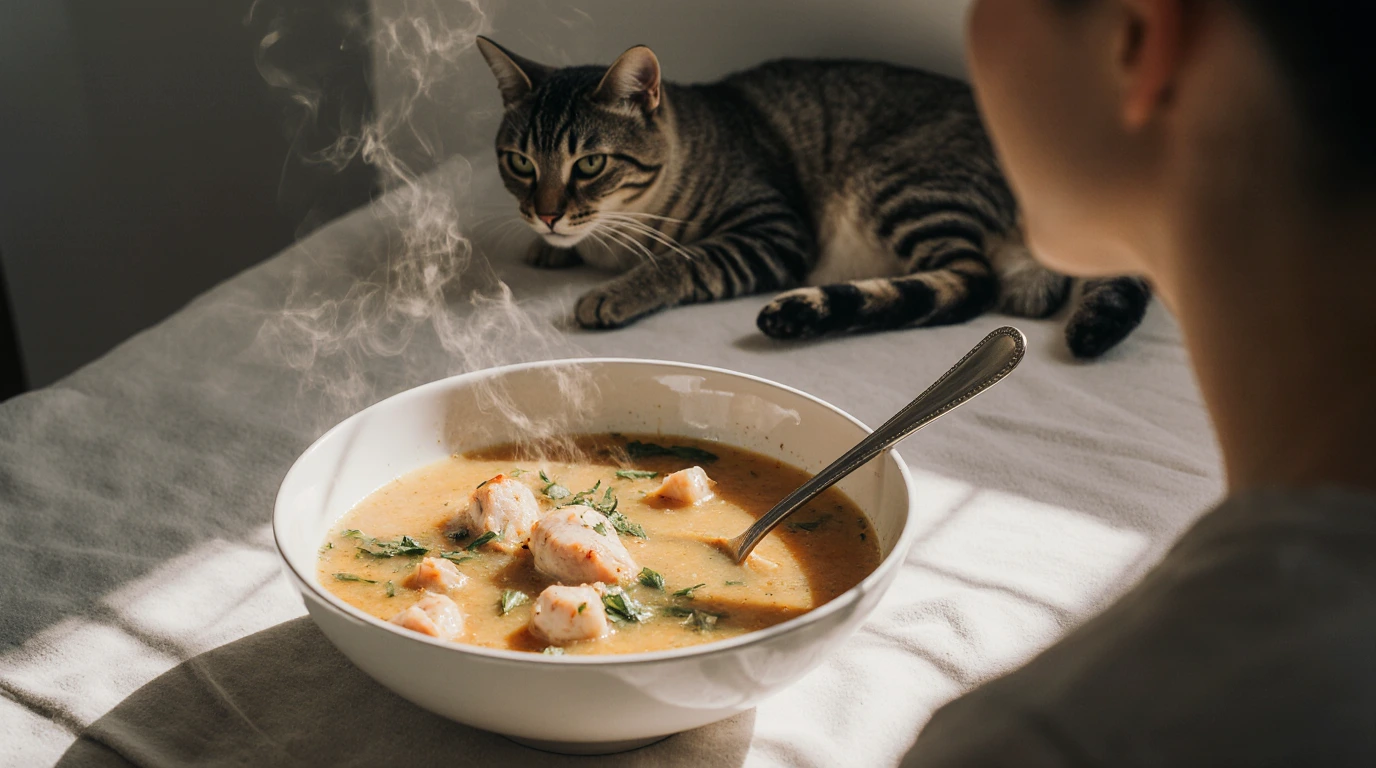Introduction:
Chicken Stock Soup for Cats – Why Your Cat Might Be Craving More Than Just Water
Let’s be honest—convincing a cat to drink more water can feel like trying to argue with a cloud. If you’ve ever watched your feline snub a water bowl like it’s offensive decor, you’re not alone. And that’s exactly where homemade chicken stock soup comes in—not as a gimmick, but as a genuinely nurturing, vet-approved way to give your cat hydration with flavor.
This isn’t your average kitchen experiment. This broth is a gentle, nourishing option for cats who struggle with kidney issues, don’t like wet food, or simply act like hydration is beneath them. Think of it as a soft culinary hug—made with love, simmered slowly, and free from all the risky ingredients in human broths (onion, garlic, salt, spices… we’re looking at you).
In this guide, you’ll learn how to make a simple yet effective chicken stock soup tailored just for cats. No additives. No fluff. Just safe, soothing comfort your cat might actually lick the bowl for. Whether you’re a longtime cat parent or just now exploring feline nutrition, this recipe is for anyone who wants their cat to feel better, stay hydrated, and maybe even enjoy the process.
Ready to stir up something that shows your cat you get them? Let’s dive in.
Table of Contents

Ingredients for Cat-Friendly Chicken Stock Soup
When it comes to cooking for cats, simplicity isn’t just a style—it’s a necessity. Their digestive systems are wired differently than ours, and even a pinch of the wrong spice can throw things off. That’s why this chicken stock recipe keeps things pure, purposeful, and perfectly safe. Chicken Stock Soup for Cats.
Below are the ingredients you’ll need to make a basic, nourishing chicken broth your cat can enjoy:
- Chicken or turkey bones (raw or cooked, no seasoning)
- Use leftover bones from a roasted bird, or raw parts like wings, necks, or backs. Avoid heavily seasoned meat.
- 1 carrot (optional)
- Adds subtle flavor and nutrients without overpowering the broth.
- 1 celery stalk (optional)
- Mild and pet-safe in small amounts; helps round out the flavor for picky eaters.
- Filtered or spring water
- Enough to fully submerge all ingredients.
⚠️ Avoid onions, garlic, leeks, salt, bouillon cubes, or any spices. Even a small amount of these can be toxic to cats.
Optional Add-Ins (Use With Caution)
If you’re experienced and your vet approves, you can consider these extras:
- A few sprigs of catnip or parsley for added appeal.
- A dash of unsweetened pumpkin puree (good for digestion).
- Bits of unseasoned chicken meat for texture or enrichment.
What’s the Most Important Ingredient?
Without question: patience. This broth works best when simmered low and slow—allowing all the goodness to leach from the bones into a rich, gelatinous base cats find irresistible.
FAQ Chicken Stock Soup for Cats – Can I use store-bought chicken broth for my cat?
Short answer: It’s risky.
Most commercial broths contain onion powder, garlic, salt, or additives that are toxic to cats—even in small amounts. If you must use store-bought, look for cat-specific broths with a clear “no onion/garlic” label and no preservatives. Chicken Stock Soup for Cats.
Instructions: How to Make Homemade Chicken Stock for Cats
This isn’t fast food—it’s slow love in liquid form. Making broth for your cat is more about intention than complexity. You’re building something simple that supports hydration, gut health, and even comfort. And the good news? It’s surprisingly easy.Chicken Stock Soup for Cats.
Step-by-Step Cooking Instructions
- Add bones, carrot, and celery to a large soup pot.
- No need to chop unless you’re short on space. Bones should be free of seasonings, sauces, or spices.
- Fill the pot with water until all ingredients are fully submerged.
- Use filtered or spring water for the cleanest flavor.
- Bring to a gentle simmer over low heat.
- Do not boil. A rolling simmer over 5–6 hours is the goal—it extracts the nutrients without clouding or overcooking the broth.
- Check occasionally and skim off foam or fat if needed.
- This keeps the broth clean and gentle for your cat’s stomach.
- Once the stock is golden and fragrant, turn off the heat and let it cool slightly.
- It should still be warm, but safe enough to handle.
- Strain thoroughly through a mesh strainer or cheesecloth.
- Discard all bones, veggies, and solids. Your final product should be a clear, golden liquid.
- Refrigerate for several hours or overnight.
- The broth will form a soft gel when cooled—this is the collagen-rich goodness cats love.
- Portion into silicone molds or ice cube trays. Freeze.
- Pop out one cube at a time to thaw and serve as needed.
How Long Does Homemade Broth Last?
- In the fridge: 3–4 days (store in sealed jars or glass containers).
- In the freezer: Up to 2 months (ice cubes are perfect for this).
Tip: If it smells “off” or has floating fat chunks after thawing, toss it and make a fresh batch. Your cat’s nose knows.
Tips & Tricks for Making the Perfect Cat-Friendly Broth
Sure, the process is straightforward—but the details are what turn a good broth into a “lick-the-bowl-clean” kind of experience for your cat. Think of this section as the stuff you wish someone told you before your first pot.Chicken Stock Soup for Cats.
Keep It Clean—Literally
After simmering, there’s often a thin layer of fat that floats to the top as it cools. While a tiny bit of fat is fine, too much can upset your cat’s stomach.
- Quick fix: Once chilled, scrape the fat layer off the top before portioning or freezing.
- Pro tip: Refrigerate before freezing—it’s easier to handle when gelled and separates better.
Get the Gel—It’s What Matters
If your broth turns into jelly after cooling, congratulations—that’s collagen magic. This “gelatin” texture means the bones released healthy nutrients like glucosamine, chondroitin, and amino acids. These support joints, gut health, and hydration.Chicken Stock Soup for Cats.
- If it doesn’t gel: It’s still usable. Try longer simmering next time, or more bones per batch.
Don’t Overdo the Veggies
Carrot and celery are there for mild flavor—not for full-on soup mode. Overloading vegetables can dilute the benefits and irritate sensitive feline stomachs.
- Keep them whole, and remove them after simmering.
- Never add onions, garlic, or seasoning blends—even tiny amounts are toxic to cats.
Ice Cube Strategy
Freezing broth into small portions is a lifesaver. Not only does it extend shelf life, it also lets you:
- Thaw just enough for one meal.
- Drop a cube into warm water to instantly rehydrate dry food.
- Offer as a warm snack for senior or sick cats.
FAQ Chicken Stock Soup for Cats – Can I feed this broth every day?
Absolutely, with balance.
One or two tablespoons per day is plenty—especially for hydration support. It’s not a meal replacement, but it’s an excellent add-on for dry or wet food. If your cat has kidney disease or dietary restrictions, always check with your vet first.
Substitutions & Variations: Tailoring Broth to Your Cat’s Needs
Not every cat has the same palate—or the same health profile. Some cats are picky, some have sensitive tummies, and others are navigating special diets (kidney care, allergies, low protein). The beauty of this broth? It’s flexible—without compromising safety.Chicken Stock Soup for Cats.
Boneless Variation (For Extra Safety)
Worried about microscopic bone fragments, even after straining? You’re not alone. Some cat parents prefer to:
- Use bone-in thighs or drumsticks, cook until the meat falls off, then discard all solids carefully.
- Or skip bones entirely and simmer unseasoned chicken meat with skin and cartilage—less collagen, but still comforting.
TL;DR: Bones = more nutrients. Meat = less risk. You decide what’s best for your cat.
No Veggie Option
You can 100% omit the carrot and celery. They’re there for trace minerals and subtle flavor—but your cat won’t miss them. If your cat has digestive issues or strict dietary needs, skip the veg and go minimalist: bones + water only.
Protein Swaps
Want to switch things up? Some cats prefer:
- Turkey bones – slightly richer taste
- Duck necks or wings – high in collagen but pricier
- Rabbit – for sensitive systems (vet-guided only)
Just be sure the meat is plain and unseasoned.
Vegetarian or Vegan? Not Quite.
This is one of those cases where human ethics and feline biology diverge. Cats are obligate carnivores—they need animal-based nutrients. While a veggie broth might seem “lighter,” it won’t meet your cat’s needs.
However: For hydration-only support (not nutrition), a bland veggie water (carrot, pumpkin, and celery) could work as a short-term trick. Just don’t rely on it long-term.
FAQ Chicken Stock Soup for Cats – Can I add supplements or cat vitamins to the broth?
Sometimes, but only with vet approval.
Adding taurine, joint supplements, or hydration powders might seem smart—but doses matter, and some nutrients break down in heat. If you’re considering supplementing, add them after the broth cools, or ask your vet for exact dosing.Chicken Stock Soup for Cats.

Frequently Asked Questions About Chicken Broth for Cats
Cat parents are nothing if not cautious—especially when it comes to DIY anything in the kitchen. So here are the most common questions (and honest answers) about this chicken stock soup for cats.
Can I use store-bought chicken broth instead?
Technically? You can. Practically? It’s risky.
Most commercial broths—even the “organic” or “low-sodium” ones—contain onion powder, garlic extract, or vague “spices” that are toxic to cats. Unless the label clearly says it’s pet-safe and contains no salt, no onion, no garlic, skip it.Chicken Stock Soup for Cats.
Safe brands: Fancy Feast Broths (clear versions), Rachel Ray Purrfect Broths, Caru Daily Dish.
How often can I give my cat homemade broth? Chicken Stock Soup for Cats.
1–2 tablespoons daily is a great place to start. It’s not a full meal, but it boosts hydration and can make meals more appealing—especially for older cats or those with kidney issues.
- For healthy cats: A little daily cube as a treat or food topper.
- For special needs: Ask your vet to adjust frequency or portion.
My cat’s picky. What if they don’t like it?
Totally fair. Cats can be stubborn little food critics. If your cat isn’t into it:
- Try warming the broth slightly—the smell intensifies and may spark interest.
- Serve it over food rather than alone.
- Experiment with different proteins (turkey, duck, rabbit).
- Offer it as a frozen treat on warm days—some cats love licking broth ice cubes.
Is this safe for kittens or senior cats?Chicken Stock Soup for Cats.
Yes—with care.
For kittens, use broth sparingly and make sure it’s fully strained and unsalted.
For seniors, broth can actually encourage appetite and improve hydration. Always check with your vet if there are underlying health concerns.
Can I use bones from rotisserie chicken?
Nope. Hard stop.
Rotisserie or takeout chickens are usually seasoned—even if it’s “just a little salt.” These additives can harm your cat. Always use plain, unseasoned bones only.
Nutrition Information: What’s Really in This Broth?
Let’s set realistic expectations: this broth isn’t a complete meal—it’s a supportive boost. Think of it like a hydration helper with a side of comfort. That said, it does offer a few nutritional perks worth noting, especially when made from scratch.
Key Nutrients in Homemade Chicken Stock for Cats
When simmered correctly, this broth offers:
- Collagen & Gelatin – Helps maintain joint flexibility and gut lining.
- Amino Acids (glycine, proline, glutamine) – Support detoxification, digestion, and cellular repair.
- Electrolytes – Small traces of magnesium, potassium, and calcium from bones and veggies.
- Moisture – Hydration is the biggest benefit, especially for dry-food eaters or cats with kidney issues.
Estimated Values (Per 1 Tbsp Serving)
- Calories: 10–15
- Protein: Trace (<1g)
- Fat: Minimal (unless unskimmed)
- Sodium: Negligible if homemade (store-bought = varies)
- Carbohydrates: 0g
- Taurine: None unless added post-cooking (heat-sensitive)
Note: These are ballpark figures. Exact numbers depend on your bones, simmer time, and added ingredients. But overall? It’s low-calorie, nutrient-light—but hydration-heavy. Which is exactly what most cats need more of.
FAQ Chicken Stock Soup for Cats – Can I rely on this for nutritional support?
Not entirely.
Homemade broth is fantastic as a supplement, not a substitute. It won’t provide essential nutrients like taurine, B12, or complete proteins. It shines as a hydration booster and flavor enhancer—but it doesn’t replace meals or prescription diets.

Conclusion:
A Simple Gesture That Speaks Volumes
In a world overflowing with gimmicky pet products and overwhelming options, going back to basics—boiling bones for broth—feels surprisingly grounding. It’s one of those rare acts of care that doesn’t just fill a bowl, but says “I see you, I get what you need.”
This homemade chicken stock soup for cats isn’t just about hydration or nutrition—it’s about comfort, routine, and that quiet connection between you and your feline companion. Whether your cat’s a senior with kidney concerns, a picky eater, or just in need of extra TLC, this broth can quietly support their health without fuss or force. Chicken Stock Soup for Cats.
You’ve now got everything you need: a clean recipe, vet-conscious options, and a few tricks for making it work in your real-world kitchen. So go ahead—brew a batch, freeze a tray, and see what your cat thinks. You might be surprised how something so simple makes such a big difference.
If you try it, let us know in the comments—what did your cat think? Did you make any tweaks? Sharing your experience could help another cat parent on the same path. Chicken Stock Soup for Cats.

